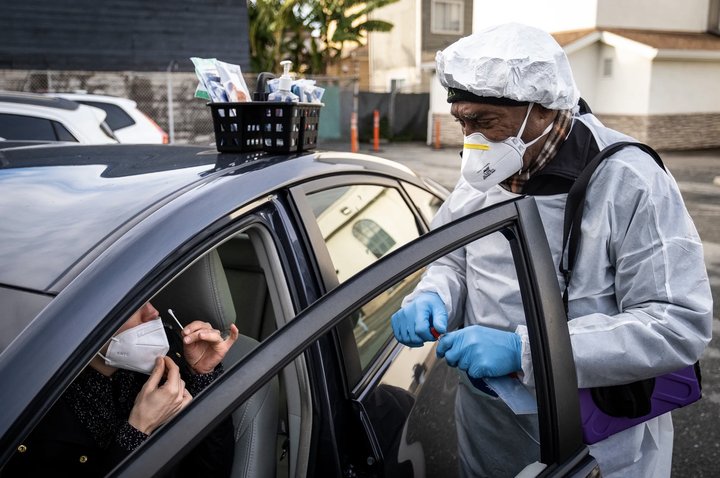Eddie Daniels administers rapid COVID-19 tests at Greater St. Paul Church in downtown Oakland on Jan. 4, 2022. Martin do Nascimento, CalMatters
Vowing to be smarter after lessons learned over the past two years, the Newsom administration today gave a glimpse of what the next few months — and potentially years — may look like in California with COVID-19 likely to stick around.
Gov. Gavin Newsom’s health secretary, Dr. Mark Ghaly, said the state’s new plan marks a shift in the handling of the pandemic toward preparedness, acknowledging that officials will have to be flexible to respond to any new variants of concern.
The state dubbed its new plan “SMARTER,” an acronym for its seven areas of focus: shots, masks, awareness, readiness, testing, education and Rx treatments.
“It is clear the virus will remain with us for some time, if not forever. It is less clear how often and how much it will continue to impact our health and well-being,” the state’s plan reads.
The strategy unveiled today includes preventive planning like stockpiling 75 million masks and bringing in 30 million over-the-counter tests, as well as the ability to increase the health care workforce by at least another 3,000 staff if there’s another surge.
It also includes building on current wastewater surveillance and genome sequencing to have a better understanding of the evolving virus, and pursuing a public-private partnership with a COVID-19 test manufacturer that can secure a supply chain for California.
The administration’s plan intentionally does not set thresholds that would trigger certain actions, like its controversial multi-colored tiered plan for closing and reopening businesses in 2020.
Instead, flexibility is important now, Ghaly said. For example, a deadly variant may require that the state focus on preventing cases, while a less virulent variant may prompt the state to focus on hospitalizations.
“Today is about balance,” Ghaly said. “Balance between a message of hope and successful adaptation but also prepared vigilance.”
The strategy comes as more than 20,000 new COVID-19 cases a day were reported in California, according to the state’s seven-day average on Wednesday. So far 8.2 million infections have been reported and 82,382 people have died since the pandemic began two years ago.
The administration promised to be more precise and targeted in its efforts to combat COVID: “We will be smarter than ever before, using the lessons of the last two years to approach mitigation and adaptation measures through effective and timely strategies,” the plan’s introduction says. “Throughout the pandemic, we have leaned on science and relied on tools that create protection.”
The strategy comes in the wake of two years that have prompted widespread criticism of the state’s handling of the pandemic:
- COVID-19 testing has been slow and fraught with shortages and long wait times — even now. Backlogs up to 65,000 people in the early months of the pandemic prompted partnerships with UC labs and the rushed building of a $25-million lab. The Valencia Branch Laboratory’s $1.7-billion no-bid contract has yet to deliver on its lofty promises of high-capacity testing.
- Booster uptake has been slow despite California making them widely available ahead of federal regulators. So far, 74% of eligible Californians have received two doses and 55% have received a booster, according to state data.
- Hospitals have struggled under the weight of the pandemic with staffing shortages and high case counts. The National Guard has been deployed multiple times, particularly in the Central Valley.
- Workers and the economy have taken a beating, with widespread omicron illnesses devastating many businesses.
Dr. George Rutherford, an epidemiologist at UC San Francisco, said the timing of the state’s plan is prudent. “There are two epidemics going on, there is the biological epidemic and there’s the epidemic of fear and angst. I think we may have aged out of that second one at a time when the biological epidemic is falling,” he said.
The plan sends a message of “we’re not going to be in the war room all the time,” he said.
Asked if the administration’s plan lacked anything, Rutherford said he thought the plan was comprehensive, and perhaps other states could look at it for guidance.
California — and the world — has been hit by four surges since the pandemic’s start. The winter 2020-21 surge killed the most people. Omicron at its peak recorded nearly three times as many cases in California compared to last winter, although fewer people have died.
Ghaly said Californians should expect seasonal upticks, like when school starts up or during the winter. With that could come masking rules and a need for more testing.
Experts predict that COVID-19 will eventually become “endemic.” To reach that phase, however, infections would have to stabilize, meaning no outbreaks or rampant upticks.
Endemic “means it’s at a constant level – that constant level may be low or it may be high, it may be somewhere in between, but it’s not going up and down,” Rutherford said.
Ideally, that case rate would be much lower than the current rates, county health officials say.
“Right now our case rate is on the high side. It is coming down, which is good to see, but it is still pretty high,” Fresno County’s public health officer Dr. Rais Vohra said in a press briefing last week. Fresno has a 7-day average daily case rate of 67.7 new cases per 100,000 people. Statewide, it’s 42.3 cases per 100,000.
“If the case transmission rate came down to say five in 100,000 people, that would be a really good sign,” Vohra said.
###
CALmatters.org is a nonprofit, nonpartisan media venture explaining California policies and politics.

CLICK TO MANAGE